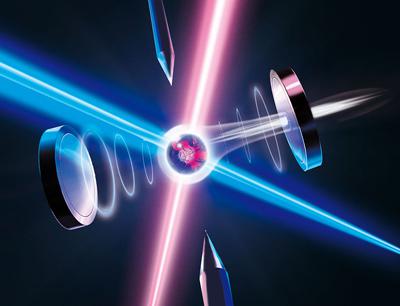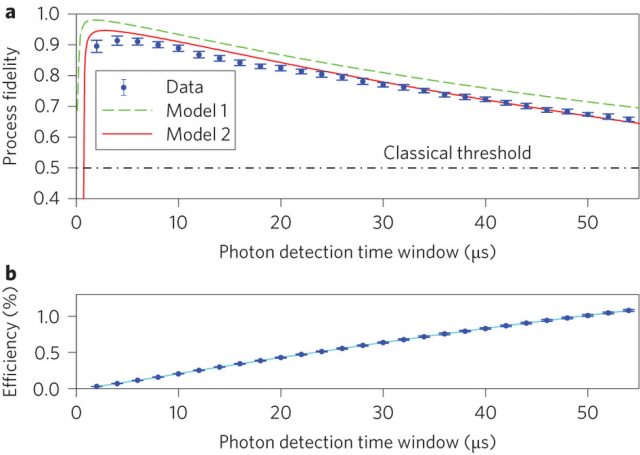Closer to quantum Internet

Quantum computers are one of the most promising technologies under development, and all their promises are completely justified. Quantum systems are extremely expensive to compute, where “expensiveness” can be measured either by the memory or the computational time required in classical computers. But it should be much cheaper if the computer uses quantum mechanics rules. The comparison is simple: if you simulate a system composed of classical particles and you double your computer memory you will be able to simulate a double number of particles (or something in the same order of magnitude). In quantum systems this scaling is much worse, the memory requirements are double for each new particle you include in your simulation. However, some typical computations will become much faster and less memory consuming if they run in quantum computers. Examples are searching for an entry in a disordered database or factorizing numbers with applications in cryptography 1.
Certainly, making a real quantum computer with a considerable computation power is highly non trivial. Even so, many important steps have already been taken in the last years. Many current researches focus on very different quantum systems as potential basic units of a quantum computer. Photons, atoms, ions, or the spin of electrons in quantum dots are some of the most popular. Each approach has its own benefits and disadvantages. For example, photons are particularly useful for transmitting quantum information, as they travel very fast and the losses in an optical fiber are very small. The main problem with photons is that they are very difficult to store, so their information should be used immediately. Ions, on the other hand, are much more stable. They can preserve their quantum properties for a longer time, even for seconds in some experiments, but they are almost impossible to transport.
Hence, if I have information stored in my ionic quantum computer and I want to send it to another computer I really have a problem. First of all I need to be aware of the problem of cloning. The information hidden in a system, that stores an unknown quantum state, cannot be copied to other systems. This fact is proved by the non-cloning theorem 2. Bad news, you should forget about making backups of your quantum information. But in any case I want to send my state to another computer, maybe because it can compute something I can’t, or because we have palarelize our computation, or because of privacy issues. What can I do if my ions are very difficult to move?
This question is at the heart of a recent work done at the University of Innsbruck 3. The main idea is simple, we can use ions for computing, and photons to transport the computed information. For that we have to develop a technique in order to perform a not so simple task, to transfer the quantum state of ions to photons. In this work they made this process in an experimental way for the simplest case, to transfer the state of a single ion to a photon.
For performing this task the authors of the paper used a single calcium atom. This ion encoded a quantum state by a superposition of two different electronic possibilities. Then a laser excites the ion and a photon comes out. This photon has in its polarization properties encoding the quantum state of the ion. This photon is stored for a moment between two mirrors and, finally, it is transferred to an optical fiber. By this procedure the state of the ion can really be transferred to a remote localization by the optical fiber. The experimental configuration is displayed in Figure 2.

The grade of success of this kind of experiments is measured by a quantity called fidelity. This quantity computes how close are we from the desired state, being one if the state is completely equal and zero in the worst case. In figure 3 we can see some of the results of the experiment.

The fidelity depends on the time the photon takes inside the cavity, having a maximum value close to one. On the other hand the efficiency of the process, that is, the number of photons detected per photon emitted is very low, around 1%. As the fidelity decreases with time and the detection increases a decision have to be taken. As an example, in order to detect 1% of the photons the fidelity should be reduced to 66%. This low efficiency is a very common problem in experiments with single photons.
In conclusion, this is an important step in the field of quantum computing. Connecting two remote quantum computers is a formidable task, and we are closer now. Even if the efficiency is very low, the fidelity of the transmitted state compared with the original one can be made extremely high, hence reducing the probability of transmitting corrupted data. By improving this technique the construction of a potential network of quantum information, a quantum Internet, is closer.
References
- M. Nielsen and I. Chuang. Quantum Computation and Quantum Information. Cambridge University Press. (2000) ↩
- W. Wootters and W. Zurek. “A Single Quantum Cannot be Cloned”. Nature 299, 802 (1982) ↩
- A. Stute, B. Casabone, B. Brandstätter, K. Friebe, T. E. Northup and R. Blatt. “Quantum-state transfer from an ion to a photon”. Nature Photonics 7, 219 (2013) ↩
2 comments
is there any way that permit amplify the sign for to have a greater fidelity without that the efficiency go down ?
By the moment it is complicate. An important point for this reduction of efficiency is based on the experiment design. They transfer the state of the ion by illuminating it with a laser, but before the ion emits the photon it can oscillate. Because of that reason there is an optimal time, if the ion “decide” to emit the photon there, it will be very similar to the state before, but in quantum mechanics you can not tell the ion when to emit the photon, and if it delayed the state is corrupted.
Other sources of error are purely technical, as the efficiency of the single photon detector, or the losses of photons.